In Hindu worship, the Shivalinga holds immense importance as it symbolizes Lord Shiva's potent energy and essence. It serves as a focal point for spiritual connection, representing the harmonious balance of creation, preservation, and destruction, while also embodying the fusion of masculine and feminine energies. This sacred symbol deepens one's spiritual practice and fosters reverence, offering a gateway to divine presence and cosmic power. Its architectural representation in temples with intricate carvings further emphasizes its cosmic energy. Embracing the Shivalinga in worship allows for a profound connection to the divine and the infinite nature of Lord Shiva.
Table of Contents
Key Takeaways
- Symbolizes Lord Shiva's dynamic energy and cosmic power.
- Represents balance of masculine and feminine energies.
- Focal point for divine connection and spiritual essence.
- Embodies creation, preservation, and destruction aspects.
- Holds immense spiritual significance and fosters reverence.
Symbol of Lord Shivas Energy
The Shivalinga symbolizes the dynamic and potent energy of Lord Shiva in Hindu worship. As a sacred symbol, it represents the energy manifestation of Lord Shiva, encapsulating his essence and power. The worship significance of the Shivalinga lies in its ability to embody the spiritual essence of Lord Shiva, making it a focal point for devotees seeking to connect with the divine presence.
In Hindu theology, the Shivalinga is revered as a symbol of creation, preservation, and destruction, reflecting the cycle of life and the cosmic forces at play. Its phallic shape symbolizes the union of masculine and feminine energies, representing the balance and harmony in the universe. Through worship and meditation upon the Shivalinga, devotees aim to harness the divine energy it embodies, seeking blessings, protection, and spiritual growth.
Architectural Representation in Temples
Represented in the architectural design of Hindu temples, the Shivalinga holds a significant and profound presence, embodying spiritual symbolism and divine essence within the sacred spaces. The Shivalinga serves as a symbolic representation of Lord Shiva's cosmic energy and creative power. Architecturally, the Shivalinga is often housed in the sanctum sanctorum of temples, surrounded by intricate carvings and sculptures that depict various mythological narratives and symbols. The linga itself is a simple cylindrical structure representing the male creative energy, while the yoni base symbolizes the female energy or the cosmic womb.
The cultural significance of the Shivalinga's architectural representation lies in its ability to blend artistic expression with spiritual devotion. The elaborate designs and craftsmanship seen in temples reflect the devotion and reverence of the worshippers towards Lord Shiva. The architectural beauty of these temples not only pleases the eyes but also creates a divine atmosphere that aids devotees in their spiritual journey. Through the intricate architectural representation of the Shivalinga, Hindu temples become not just places of worship but also centers of artistic and cultural expression.
Spiritual Significance in Hinduism
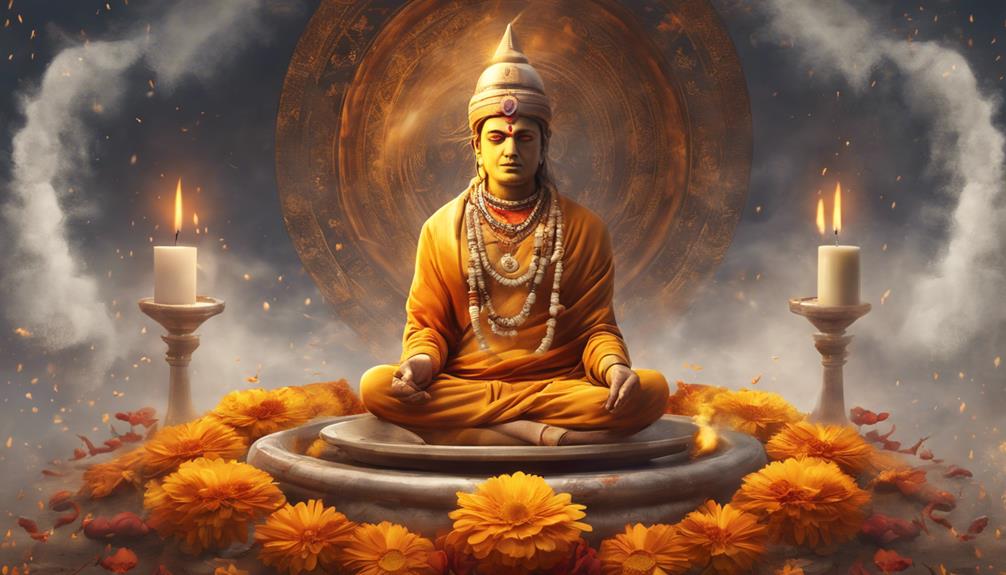
The Shivalinga holds immense spiritual significance in Hinduism. It symbolizes the act of creation in the universe and represents the energy that flows through all living beings. It's believed to embody the divine cosmic power that governs existence. The Shivalinga serves as a focal point for worshippers to connect with the divine presence within themselves.
Understanding the symbolic nature of the Shivalinga can deepen one's spiritual practice and foster a profound sense of reverence for the interconnectedness of all life.
Symbol of Creation
Symbolizing the act of creation in Hinduism, the Shivalinga holds profound spiritual significance in worship practices. The Shivalinga serves as a powerful representation of creation symbolism and cosmic significance in Hindu theology. It embodies the concept of divine power and the cosmic forces that govern the universe.
The shape of the Shivalinga is often associated with the cosmic egg or the cosmic pillar, symbolizing the endless nature of creation and the universe. Through the worship of the Shivalinga, devotees seek to connect with the divine energy that flows through the universe and recognize the omnipresent nature of the divine force.
The Shivalinga stands as a sacred emblem of creation and a reminder of the divine power that sustains all existence.
Representation of Energy
In Hindu worship practices, the Shivalinga embodies a profound representation of spiritual energy, reflecting the divine power that governs the universe. The Shivalinga symbolizes the cosmic pillar of energy, representing the unification of the masculine and feminine energies – Shiva and Shakti. This unity signifies the balance and harmony in the universe, where creation and destruction coexist.
The shape of the Shivalinga, often depicted as an elliptical form, is believed to encapsulate this dynamic energy flow. Devotees worship the Shivalinga to connect with this cosmic energy and seek blessings for spiritual growth and protection. The act of pouring water or milk over the Shivalinga in temples is a symbolic representation of nurturing and honoring this divine energy within oneself.
Divine Cosmic Power
Embodying the essence of divine cosmic power, the Shivalinga in Hinduism serves as a focal point for spiritual reverence and connection. The Shivalinga represents the infinite cosmic energy that sustains the universe, symbolizing the unmanifest form of Lord Shiva.
Through worship practices centered around the Shivalinga, devotees endeavor to tap into this divine cosmic power, aiming to align themselves with the universal forces that govern existence. The act of worshiping the Shivalinga isn't merely a ritualistic practice but a profound spiritual pursuit aimed at recognizing and honoring the omnipresent energy that flows through all creation.
Rituals and Offerings Associated
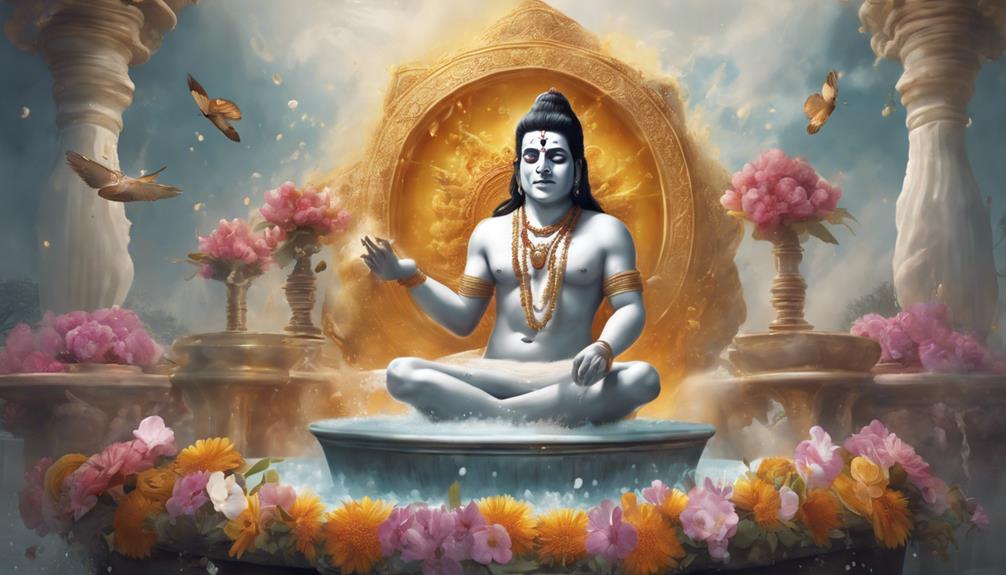
You engage in sacred rituals to honor Lord Shiva through the Shivalinga, offering flowers, water, milk, and bilva leaves to symbolize devotion and purity.
These rituals and offerings form a significant part of Hindu worship, reflecting the devotee's reverence and connection to the divine.
The act of presenting these offerings is a symbolic gesture of respect, faith, and spiritual connection to the cosmic energy represented by the Shivalinga.
Sacred Rituals Performed
Sacred rituals performed around the Shivalinga in Hindu worship involve intricate ceremonies and specific offerings that hold deep symbolic significance within the religious tradition. Ritualistic practices surrounding the Shivalinga, such as the pouring of water, milk, or honey, aren't merely actions but are imbued with profound meaning.
These acts symbolize the purification of the soul and the offering of the devotee's devotion to Lord Shiva. The circular shape of the Shivalinga represents the infinite nature of Shiva's power and the cyclical nature of creation and destruction.
Offerings to Symbolize
In the context of Hindu worship centered around the Shivalinga, the offerings made hold deep symbolic significance, embodying the devotee's reverence and spiritual connection to Lord Shiva. Historically, offerings to the Shivalinga have been an integral part of worship practices, with ancient rituals emphasizing purity and devotion through offerings of water, milk, flowers, fruits, and incense.
These offerings symbolize the devotee's gratitude, love, and surrender to the divine presence represented by the Shivalinga. In modern interpretations, while traditional offerings are still prevalent, contemporary practices have expanded to include items like honey, ghee, and even precious gems.
The act of making offerings to the Shivalinga continues to be a sacred ritual that bridges the gap between the physical and spiritual dimensions for devotees seeking communion with Lord Shiva.
Connection to Creation and Destruction
The Shivalinga symbolizes the eternal cycle of creation and destruction in Hindu worship. It represents the cosmic energy of the universe, embodying both the creative and destructive aspects of Lord Shiva. In Hindu theology, creation and destruction are intertwined forces essential for the continuation of life and the universe.
The concept of creation in Hinduism is linked to Brahma, the creator, who brings life into existence. The Shivalinga, through its phallic shape, signifies the generative power of creation. It symbolizes the potential for growth, renewal, and the emergence of new life forms. On the other hand, destruction, associated with Lord Shiva as the destroyer, is necessary for the cycle of rebirth and regeneration. The Shivalinga's Yoni base represents the cosmic womb from which life emerges and where it ultimately returns for dissolution.
In Hindu worship, devotees recognize the interconnectedness of creation and destruction, acknowledging the impermanence of existence and the eternal nature of the cosmos through the symbolism of the Shivalinga.
Diversity in Shivalinga Forms
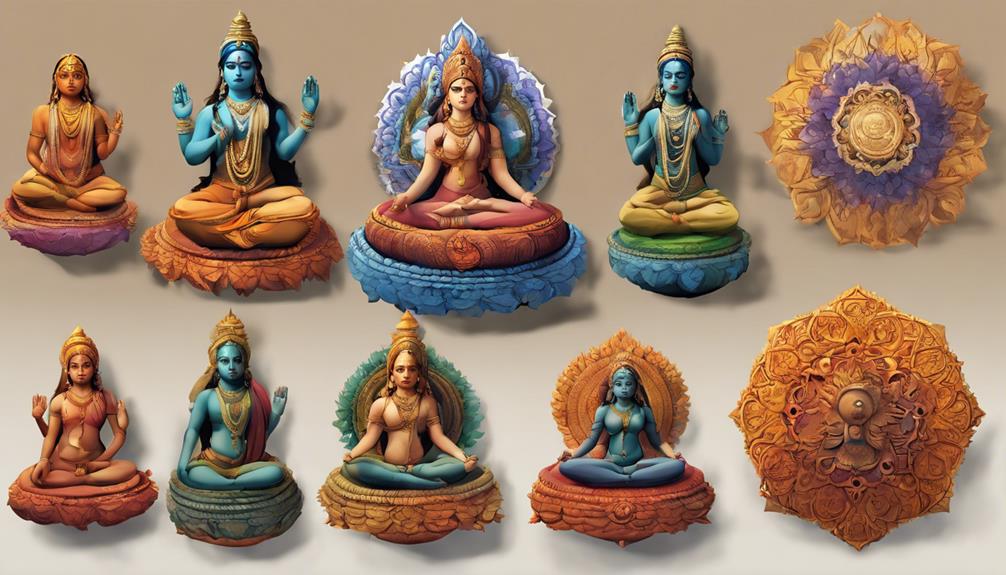
Displaying a myriad of forms and representations, the Shivalinga manifests diverse characteristics in Hindu worship, reflecting the multifaceted nature of Lord Shiva's manifestations.
The different forms of Shivalinga serve various purposes in ritual practices and artistic representations. In ritual practices, devotees may encounter Shivalingas made of various materials such as stone, crystal, or metal, each believed to carry unique energies and symbolism. These diverse forms allow worshipers to connect with different aspects of Lord Shiva's divine presence, catering to individual spiritual inclinations.
Additionally, artistic representations of the Shivalinga showcase the creative interpretations of artists, depicting the essence of Shiva's energy through intricate designs and symbolic elements. The diversity in Shivalinga forms not only adds richness to the visual and tactile aspects of worship but also deepens the spiritual experience by offering a range of expressions to explore and connect with the divine.
Through these varied forms, devotees can engage with Lord Shiva in ways that resonate most with their personal beliefs and spiritual journey.
Role in Meditation and Yoga
The Shivalinga serves as a focal point for meditation, aiding in concentration and the deepening of spiritual practices.
In yoga, the Shivalinga is believed to be a powerful conduit of spiritual energy, enhancing the practitioner's connection to the divine.
Its symbolic representation of the infinite and eternal nature of the divine makes it a potent tool for those seeking to elevate their spiritual consciousness through meditation and yoga.
Meditation Aid
Playing a significant role in meditation and yoga practices, the Shivalinga serves as a powerful focal point for concentration and spiritual connection. In mindfulness practice, individuals often use the Shivalinga as a point of focus to cultivate awareness of the present moment. By concentrating on the Shivalinga, practitioners enhance their breath awareness, allowing them to deepen their meditation experience.
Additionally, the Shivalinga aids in concentration techniques by providing a tangible object for the mind to center upon, promoting mental clarity and focus. Through visualization methods, individuals can envision the divine energy embodied by the Shivalinga, facilitating a deeper spiritual connection during meditation and yoga sessions.
The Shivalinga's symbolic representation of the divine essence makes it a valuable tool for enhancing the meditative experience.
Spiritual Energy Conduit
Serving as a conduit for spiritual energy in meditation and yoga practices, the Shivalinga channels divine essence to deepen practitioners' connection to the sacred during their spiritual endeavors. This sacred symbol acts as a focal point for energy transmission, enhancing the spiritual practice of individuals.
In meditation, the Shivalinga aids in concentration, allowing one to explore further into introspection and self-realization. Through its representation of the divine, the Shivalinga facilitates a profound connection to the spiritual domain, guiding worshippers towards a heightened state of awareness and enlightenment.
Cultural Importance in Festivals
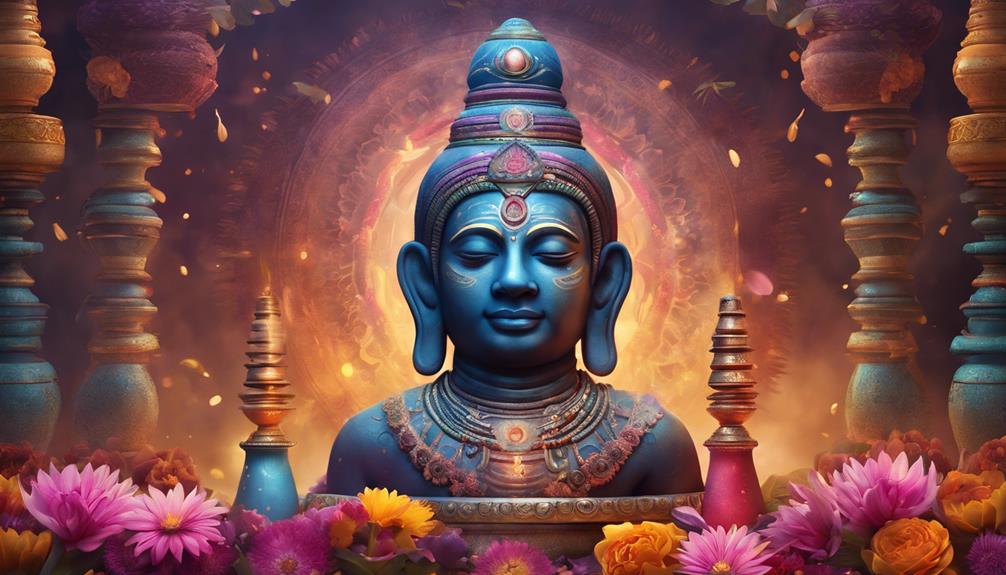
During Hindu festivals, the cultural significance of the Shivalinga is prominently displayed in various rituals and ceremonies. The Shivalinga, representing the infinite nature of Lord Shiva, holds immense festival symbolism and cultural importance in Hindu traditions. Traditional practices surrounding the Shivalinga during festive celebrations serve as a means to connect with the divine and reinforce the devotee's spiritual beliefs.
In festivals like Maha Shivaratri, devotees offer various items like milk, water, and flowers to the Shivalinga as a symbol of devotion and gratitude. These rituals not only honor Lord Shiva but also symbolize the cycle of creation, preservation, and dissolution. The festive celebrations act as a communal gathering where individuals come together to partake in prayers, bhajans, and other rituals centered around the revered Shivalinga.
The cultural importance of the Shivalinga in festivals extends beyond religious boundaries, serving as a unifying force that brings communities together in celebration and reverence for the divine essence it represents.
Beliefs and Mythological Stories
The Shivalinga, a revered symbol in Hindu worship, is steeped in beliefs and mythological stories that intricately weave together the divine essence of Lord Shiva with the cosmic narratives of creation and destruction. Hindu beliefs hold that the Shivalinga represents the infinite nature of Lord Shiva, encapsulating his energy and power in a compact form that devotees can worship. Mythological stories surrounding the Shivalinga often depict events where Lord Shiva's supremacy and benevolence are highlighted, emphasizing the significance of this sacred symbol in Hindu theology.
The Shivalinga's energy representation is central to its worship, as devotees believe that by praying to the Shivalinga, they can harness the divine energy of Lord Shiva for protection, prosperity, and spiritual growth. This belief is reflected in the intricate temple architecture designed to house the Shivalinga, with temples often constructed to align with cosmic principles and facilitate the flow of divine energy within the sacred space. As such, the Shivalinga serves as a focal point for devotion, meditation, and spiritual communion in Hindu worship.
Global Reverence and Devotion
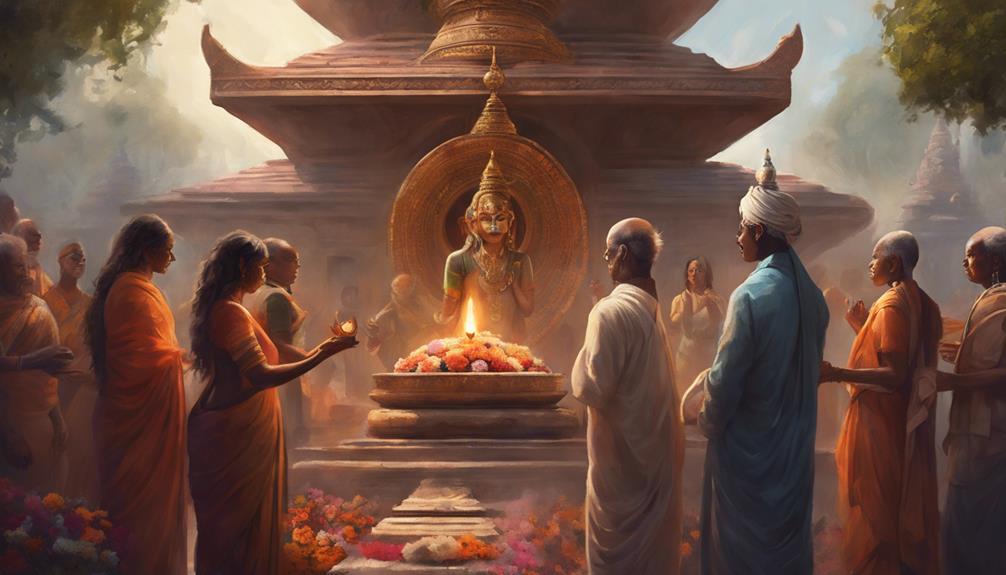
Global reverence and devotion towards the Shivalinga symbolize the widespread embrace of Lord Shiva's divine energy and presence beyond geographical and cultural boundaries. The global devotion to the Shivalinga highlights its cultural significance as a unifying symbol of reverence and spiritual connection among Hindus worldwide. The Shivalinga serves as a focal point for devotees to express their devotion and connect with the transcendental aspect of the divine. Regardless of one's cultural background or geographical location, the Shivalinga stands as a powerful representation of Lord Shiva's omnipresence and omnipotence.
The reverence towards the Shivalinga transcends linguistic and cultural barriers, uniting followers in their shared faith and devotion to Lord Shiva. This global reverence underscores the universal appeal of Shiva's divine energy and the enduring significance of the Shivalinga in Hindu worship practices. The spiritual connection that devotees establish with the Shivalinga goes beyond ritualistic worship; it symbolizes a profound communion with the cosmic energy that Lord Shiva represents. Through global devotion to the Shivalinga, Hindus worldwide reaffirm their spiritual bond with Lord Shiva and the eternal principles he embodies.
Frequently Asked Questions
How Did the Practice of Worshipping the Shivalinga Originate in Hinduism?
Originating from the ancient Hindu traditions, the practice of worshipping the Shivalinga symbolizes the divine presence of Lord Shiva. The shape denotes the formless nature of the deity, fostering a deep spiritual connection among devotees.
Are There Any Specific Rules or Guidelines for How to Perform Rituals and Offerings to the Shivalinga?
When engaging with the Shivalinga, observe ritual etiquette and offerings protocol. Follow worship customs and sacred rituals meticulously. Pay attention to the guidelines laid out by tradition to guarantee your worship is conducted with reverence and respect.
Can the Shivalinga Be Found in All Hindu Temples, or Are There Specific Temples Dedicated Solely to Lord Shiva?
In Hinduism, specific temples are solely dedicated to Lord Shiva, where Shivalinga worship is central. These temples adhere to intricate Hindu rituals, emphasizing the significance of the Shivalinga as a representation of divine energy and creation.
Are There Any Specific Mantras or Prayers That Are Commonly Recited During Worship of the Shivalinga?
During worship of the Shivalinga, devotees commonly recite mantras and chants to honor Lord Shiva. These sacred rituals and offerings play a significant role in Hindu worship, fostering a deep spiritual connection with the divine.
What Are Some Common Misconceptions or Misunderstandings About the Significance of the Shivalinga in Hindu Worship?
One common misconception about the Shivalinga is misunderstanding its symbolism. Its cultural significance and rituals are often misinterpreted. Exploring its multifaceted meanings in Hindu worship can help clarify these misconceptions.
Conclusion
To sum up, the Shivalinga holds immense significance in Hindu worship as a symbol of Lord Shiva's energy, representing both creation and destruction.
It plays a crucial role in rituals, meditation, and yoga, while also being a central focus in temples and festivals.
Its spiritual importance, cultural value, and global reverence reflect the deep devotion and beliefs associated with this sacred symbol in Hinduism.